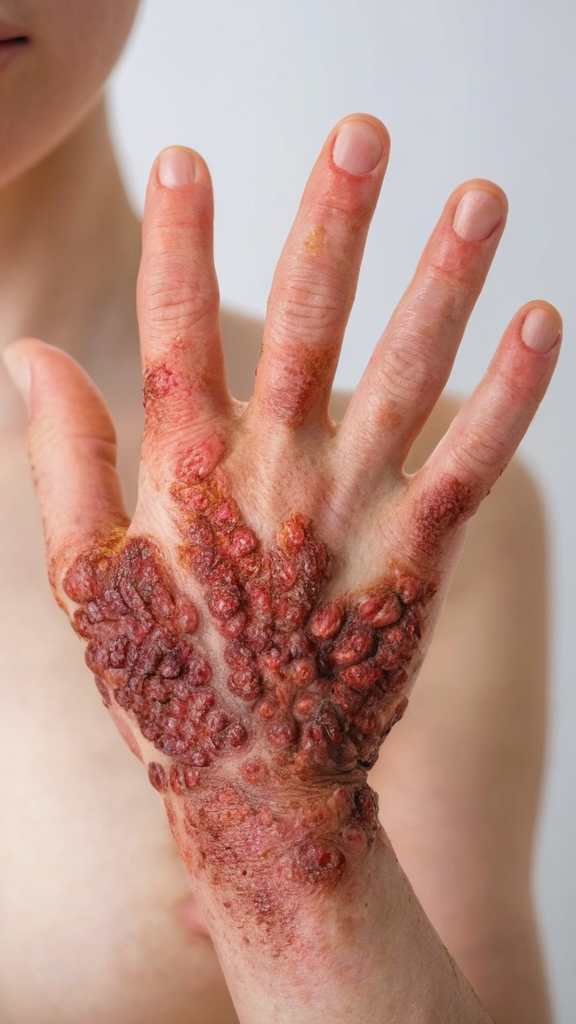The Best Fluffy Pancakes recipe you will fall in love with. Full of tips and tricks to help you make the best pancakes.

Is Dyshidrotic Eczema Dangerous
Understanding the Risks: Is Dyshidrotic Eczema Dangerous?
Dyshidrotic eczema, also known as pompholyx, is a skin condition characterized by small, itchy blisters, primarily appearing on the hands and feet. If you are experiencing this condition, you may wonder whether it poses any dangers. Understanding the risks associated with dyshidrotic eczema can help you make informed decisions about your health and treatment options.
This form of eczema can certainly be uncomfortable and seems to flare up without any clear reason. The blisters might not appear dangerous at first glance, but they can lead to complications if not treated properly. Here are several important aspects to consider regarding the potential dangers of dyshidrotic eczema:
Skin Integrity Issues
When you have dyshidrotic eczema, the blisters can cause significant irritation and may even break open. Here’s a look at the risks of skin integrity issues:
- Infection: Open blisters can be a gateway for bacteria, leading to skin infections. These infections can further complicate the condition and may require medical intervention.
- Scarring: Chronic scratching or picking at the blisters can result in scarring, which may lead to long-lasting skin changes.
- Discomfort and Pain: The itching and discomfort can negatively impact your quality of life, making it hard to perform daily activities.
Allergic Reactions and Sensitivities
Identifying triggers for dyshidrotic eczema is essential, as allergens can worsen the condition. Here are some common allergens and irritants that may pose risks:
- Soap and other personal care products
- Household cleaners
- Nickel and other metals
- Certain foods, such as nuts and shellfish
Exposure to any of these allergens can aggravate your symptoms and heighten the severity of the flare-up.
Psychological Effects
Living with a skin condition can have psychological implications. The visibility of the blisters on the hands and feet can lead to:
- Low self-esteem: People may feel self-conscious about their appearance, especially in social situations or workplaces.
- Anxiety and Stress: The constant worry about flare-ups and how they impact daily life can lead to increased anxiety.
It’s important to seek support, whether through counseling or supportive groups, for emotional well-being.
Management and Treatment Options
To mitigate the risks of dyshidrotic eczema, it’s crucial to follow a proper management plan:
- Moch unavailable for treatment: Moisturize regularly to help maintain the skin barrier.
- Avoid known triggers: Keeping a journal to track flare-ups can help you identify and avoid triggers.
- Medications: Consult a healthcare provider for topical corticosteroids or other topical treatments that can relieve symptoms.
- Cool compresses: Using a cool compress can alleviate discomfort and reduce itching.
When to Seek Medical Help
If your symptoms worsen or do not improve with self-care, it is essential to consult a healthcare professional. Signs that you should seek medical attention include:
- Signs of infection, such as increased redness, warmth, or pus
- Severe itching that disrupts daily activities
- Blisters that do not improve with home remedies
Final Thoughts
While dyshidrotic eczema is not life-threatening, it can result in complications that affect your skin and emotional well-being. By understanding its potential dangers and proactive management strategies, you can minimize risks and improve your quality of life.
Effective Management Strategies for Dyshidrotic Eczema Symptoms
If you’re experiencing dyshidrotic eczema, you’re not alone. This skin condition can cause painful blisters on your hands and feet, leading to discomfort and frustration. Understanding how to manage dyshidrotic eczema symptoms effectively is essential for improving your quality of life. Here are some proven strategies you can use to alleviate the symptoms and reduce flare-ups.
Understanding Dyshidrotic Eczema
Dyshidrotic eczema, also known as pompholyx, mainly affects the hands and feet. Symptoms may include:
- Small, itchy blisters
- Red and inflamed skin
- Dryness and cracks in the skin
Identifying triggers is crucial for managing your condition. Common triggers include stress, sweating, and exposure to certain metals like nickel. By understanding what flares up your symptoms, you can take steps to avoid these triggers.
Moisturize Regularly
Keeping your skin moisturized is one of the best ways to manage dyshidrotic eczema. Use thick, fragrance-free creams or ointments. Here are a few tips on effective moisturizing:
- Apply moisturizer immediately after bathing to lock in moisture.
- Choose creams containing ingredients such as ceramides, shea butter, or glycerin.
- Consider using a humidifier to add moisture to the air in your home.
Avoid Irritants
It’s essential to avoid substances that can irritate your skin. Here are some common irritants to steer clear of:
- Harsh soaps or detergents
- Certain fabrics, such as wool or synthetic materials
- Household cleaners with strong chemicals
When doing chores, consider wearing gloves to protect your hands from direct contact with irritants.
Cool Compresses
Applying cool compresses can help reduce itching and inflammation. Follow these simple steps:
- Soak a clean cloth in cool water.
- Wring it out and place it on the affected areas for 15–20 minutes.
- Repeat several times a day as needed for relief.
Medications and Treatments
If your symptoms are severe, you may need to consult a healthcare professional. They might recommend treatments such as:
- Topical corticosteroids to reduce inflammation
- Calcineurin inhibitors for long-term usage
- Oral antihistamines for itching relief
Never start new medications without consulting your healthcare provider first. It’s essential to find a treatment plan that works for you.
Stress Management
Stress can significantly impact dyshidrotic eczema. Here are some effective strategies to reduce stress:
- Practice mindfulness or meditation to help you relax.
- Engage in regular physical exercise, which can improve your mood.
- Establish a regular sleep routine to ensure you get adequate rest.
| Strategy | Description |
|---|---|
| Moisturize | Use thick creams after bathing. |
| Avoid Irritants | Limit exposure to harsh chemicals and irritating fabrics. |
| Cool Compresses | Apply cool cloths for itch relief. |
| Medications | Consult a doctor for prescription options. |
| Stress Management | Incorporate relaxation techniques into your routine. |
Regular Check-ups
It’s important to have regular check-ups with your dermatologist. They can help you monitor your condition and make adjustments to your treatment plan as necessary. Keeping an open line of communication with your healthcare team can lead to better management of your symptoms over time.
Dyshidrotic eczema can be a frustrating condition, but with the right management strategies, you can minimize your symptoms and lead a more comfortable life. By moisturizing, avoiding irritants, and using effective coping strategies, you can take control of your skin health.
Conclusion
Addressing dyshidrotic eczema and its potential dangers is crucial for anyone who experiences symptoms. While it may not be life-threatening, this condition can significantly impact your quality of life, causing discomfort, itching, and even secondary infections if not managed properly. Understanding the risks associated with dyshidrotic eczema can help you identify effective strategies to live with it.
Implementing management techniques can be transformative. Keeping your skin moisturized, avoiding known triggers, and utilizing topical treatments can greatly reduce flare-ups. It’s also beneficial to adopt a consistent skincare routine, which might include wearing gloves when handling irritants and stress management techniques. Engaging with healthcare professionals can help craft a personalized approach that addresses your specific symptoms.
Recognizing that while dyshidrotic eczema can be frustrating, the right strategies can empower you to manage it effectively. By staying informed and proactive, you can minimize its effects on your daily life. Make sure to listen to your body, learn what works best for you, and don’t hesitate to seek support from dermatologists or support groups. This journey is not just about managing symptoms; it’s about reclaiming the joy and comfort in your skin. You don’t have to face this condition alone, and with the right resources, you can lead a fulfilling life despite the challenges of dyshidrotic eczema.

